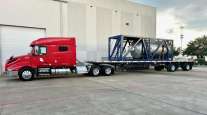Flatbed Carrier Rates Increase as Freight Swamps Capacity
This story appears in the June 14 print edition of Transport Topics.
Flatbed trucking, which has been battered by declines in manufacturing and construction during the recession, is finally showing sustained signs of improvement, with better volumes leading to freight-rate increases, carriers and their shippers have said.
Several executives in the sector said the improvement in carrier health is due to gains in freight levels, combined with a substantial drop in total carrier capacity.
It’s unclear whether the freight increase will continue, but so far many shippers said they had turned to brokers to help them find carriers, and an electronic load board’s load-to-truck ratio for flatbeds jumped from 7.1 loads chasing a truck in January to better than 30-to-1 in May and June.
“Shippers of building products and steel have all been scrambling to find trucks,” said Wayne Johnson, logistics director of American Gypsum Co., Dallas. Johnson said he has seen some flatbed rates rise by 45% in about three weeks, depending upon the traffic lane.
The freight surge started early this year, running at least until May. Whether strong growth will continue through June is uncertain.
Fairfield Trucking, Hamburg, Ark., got busier in late March and saw business build from there, said Diann Barnes, chief operating officer. “We realized there was no excess capacity in the industry as soon as customers pushed the capacity button.”
Barnes said she has noticed a recent dip in lumber shipping but thinks that is the result of lumber buyers testing for the bottom of lumber pricing. When that point is reached, she said, she expects to see an increase in shipping.
“We haven’t seen a rate dip,” she said. “I think shippers are now realizing there is a shortage of trucks.”
American Gypsum’s Johnson said he had to use brokers, and they were generally successful at finding surge capacity for hauling freight.
“The asset-based companies didn’t have the trucks,” he said. “After having trucks parked and not enough drivers, their supply wasn’t adequate.”
TransCore’s 3sixty Freight Match load board tracks flatbed activity, and Senior Vice President David Schrader said, “Flatbed activity was beyond tight through April but showed signs of moderation as we progressed through May.”
TransCore’s analysis found that its load-to-truck ratio increased for flatbeds and the first half of this year has been the strongest in terms of load postings during the 2005-2010 period.
Shippers of big products are reporting better business, and the results are being passed to their carriers.
“We’re much improved over a year ago at this time. It’s a decent business climate,” said Robert Ragan, senior vice president of finance for Melton Truck Lines, Tulsa, Okla. He said existing customers need more shipping, and Melton also is taking calls from new shippers interested in getting some time from the carrier’s 850 trucks.
The rate of housing starts fell by 79% from January 2006 to April 2009, the Commerce Department said. However, in the year since then, housing starts regained almost 11% of what they lost.
The Federal Reserve System’s Industrial Production Index fell 14.8% over the 18 months that ended in June 2009 and then recouped 39% of the loss over the next 20 months.
Construction spending “rebound-ed strongly” in April, the Associated General Contractors of America said June 1, with an increase of 2.7%, or $23 billion, from March to a seasonally adjusted annual rate of $869 billion, according to the AGC. The trade group said the gains were driven primarily by private residential construction, which was up 4.4%, and public construction, up 2.4%.
Now that business is improving, the shippers are facing a diminished carrier base. Arrow Trucking, Tulsa, Okla., with more than 1,000 trucks, filed for bankruptcy in January, and then it dissolved (3-29, p. 8).
The company had been the ninth-largest flatbed carrier on the Transport Topics 100 list of the largest for-hire trucking firms in the United States and Canada. Smaller flatbed firms went under, too.
“We’ve seen a lot of flatbed carriers with less than 50 trucks go out of business over the last two years, and they were a good source of capacity, said Kyle Alexander, director of strategic carrier development for logistics provider Transplace Inc., Frisco, Texas.
The company’s managers have seen double-digit spikes in flat-bed rates in certain lanes and have had to dig more deeply than usual into their carrier rosters to find capacity to fulfill shipper demands, Alexander said.
Lone Star Transportation, Fort Worth, Texas, offered the most cautious assessment, but Vice President David Ferebee said business has improved and probably will remain steady for his company’s 500 tractors in the flatbed sector.
“We’ve seen an uptick. There’s more stability in the market,” Ferebee said, adding that his dispatchers usually have several loads to choose from after serving core customers. He said that it was far too early to become completely bullish.
“Pricing is now stable, whereas last year at this time, it was under heavy pressures . . . but there’s still a lot of uncertainty in the market place,” Ferebee said. “Look at the stock market and the European economies. Unemployment is still high. You have to wonder what’s really out there.”


